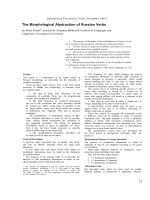the big silver book of russian verbs -555 fully conjugated verbs
Bạn đang xem bản rút gọn của tài liệu. Xem và tải ngay bản đầy đủ của tài liệu tại đây (2.48 MB, 673 trang )
THE
BIG
SILVER
BOOK OF RUSSIAN VERBS
555
FULLY CONJUGATED VERBS
Jack E. Franke, Ph.D.
Copyright © 2005 by Jack Franke. All rights reserved. Manufactured in the United States of
America. Except as permitted under the United States Copyright Act of 1976, no part of this
publication may be reproduced or distributed in any form or by any means, or stored in a database
or retrieval system, without the prior written permission of the publisher.
0-07-146003-9
The material in this eBook also appears in the print version of this title: 0-07-143299-X.
All trademarks are trademarks of their respective owners. Rather than put a trademark symbol
after every occurrence of a trademarked name, we use names in an editorial fashion only, and to
the benefit of the trademark owner, with no intention of infringement of the trademark. Where
such designations appear in this book, they have been printed with initial caps. McGraw-Hill
eBooks are available at special quantity discounts to use as premiums and sales promotions, or for
use in corporate training programs. For more information, please contact George Hoare, Special
Sales, at or (212) 904-4069.
TERMS OF USE
This is a copyrighted work and The McGraw-Hill Companies, Inc. (“McGraw-Hill”) and its
licensors reserve all rights in and to the work. Use of this work is subject to these terms. Except
as permitted under the Copyright Act of 1976 and the right to store and retrieve one copy of the
work, you may not decompile, disassemble, reverse engineer, reproduce, modify, create
derivative works based upon, transmit, distribute, disseminate, sell, publish or sublicense the
work or any part of it without McGraw-Hill’s prior consent. You may use the work for your own
noncommercial and personal use; any other use of the work is strictly prohibited. Your right to
use the work may be terminated if you fail to comply with these terms.
THE WORK IS PROVIDED “AS IS.” McGRAW-HILL AND ITS LICENSORS MAKE NO
GUARANTEES OR WARRANTIES AS TO THE ACCURACY, ADEQUACY OR
COMPLETENESS OF OR RESULTS TO BE OBTAINED FROM USING THE WORK,
INCLUDING ANY INFORMATION THAT CAN BE ACCESSED THROUGH THE WORK
VIA HYPERLINK OR OTHERWISE, AND EXPRESSLY DISCLAIM ANY WARRANTY,
EXPRESS OR IMPLIED, INCLUDING BUT NOT LIMITED TO IMPLIED WARRANTIES
OF MERCHANTABILITY OR FITNESS FOR A PARTICULAR PURPOSE. McGraw-Hill and
its licensors do not warrant or guarantee that the functions contained in the work will meet your
requirements or that its operation will be uninterrupted or error free. Neither McGraw-Hill nor its
licensors shall be liable to you or anyone else for any inaccuracy, error or omission, regardless of
cause, in the work or for any damages resulting there from. McGraw-Hill has no responsibility
for the content of any information accessed through the work. Under no circumstances shall
McGraw-Hill and/or its licensors be liable for any indirect, incidental, special, punitive,
consequential or similar damages that result from the use of or inability to use the work, even if
any of them has been advised of the possibility of such damages. This limitation of liability shall
apply to any claim or cause whatsoever whether such claim or cause arises in contract, tort or
otherwise.
DOI: 10.1036/0071460039
Want to learn more?
We hope you enjoy this
McGraw-Hill eBook! If
you’d like more information about this book,
its author, or related books and websites,
please
click here.
Russian Tense Profiles 1
ț Easy-to-view summaries of formation and uses of each tense
The Basics of Conjugation 2
The Persons of the Verb 2
The Stem 3
Verbal Aspect 4
Tense 5
Conjugation 6
Mood 6
The Present Tense 7
The Past Tense 15
The Future Tense 17
The Subjunctive Mood 19
Participles 20
Verbal Adverbs 25
Commands (The Imperative) 26
Reflexive Verbs 27
Verbs of Motion 28
The Multidirectional Verb of Motion 28
The Unidirectional Verb of Motion 29
The Prefixed Verb of Motion 30
The Verb of Motion by Vehicle 31
Russian Motion Verb Index 32
555 Fully Conjugated Verbs 33
ț Alphabetically ordered with examples of common use
Top 50 Verbs: Full page of examples adjoining select conjugations
Verb Exercises
642
ț Drills to test and improve your grasp of correct verb forms
Answers to Exercises 647
English-Russian Verb Index 648
ț 555 verb models cross-referenced by their English meaning
Irregular Verb Index 654
ț Index showing the infinitive of irregular Russian verb forms
Russian Verb Index 657
ț More than 2,000 verbs cross-referenced to the full verb models
Contents
iii
Big Silver pp i-iv 10/28/04 1:08 PM Page iii
For more information about this title, click here
Preface
The Big Silver Book of Russian Verbs is intended for use with all major Russian language text-
books in any course from the first through the fourth years, or separately as a reference for inde-
pendent study. This book is comprised of verbs from the most popular textbooks in use today, as
well as reflecting frequency usage in contemporary Russian. The aim of this book is to provide
students with a single reference that they can turn to for questions on conjugation, stems, collo-
cations, and usage.
I am grateful to the following professors for their efforts in promoting Russian, and those who
provided me the foundation and inspiration to write this book: Ronni Gordon, David Stillman,
Jean Rose, Norma Barr, William Lewis, Gerald Earvin, Sophia Lubensky, Benjamin Rifkin,
Thomas Garza, Charles McDowell, Nina Aleksandrovna Lubimova, and Anto Knezevic. I would
like to express my appreciation to two colleagues who typed large portions of this manuscript:
Stephanie Rodriguez and John S. Holsonbach.
Numerous references were consulted in the preparation of this book. These include:
The Russian Verb: Prepositional and Non-Prepositional Government (Andreyeva Georg and Tolma-
chova, Moscow: Russky yazyk Publishers, 1983) was used for verbal government.
Fundamentals of Russian Verbal Government for Students and Teachers (Thomas J. Garza, Dubuque,
Iowa: Kendall/Hunt Publishing, 1994) was incorporated for the Jackobsonian one-stem verbal
stem system.
Complete Handbook of Russian Verbs (L.I. Pirogova, Lincolnwood, Illinois: Passport Books, 1995)
served as a basis to simplify Russian verbal conjugations into six classes and irregular verbs.
Bol’shoi Tolkovyj Slovar’ Russkogo Yazyka (S.A. Kuznetsov, St. Petersburg: Norint, 1998) provided
numerous contemporary examples and usage in the modern, post-soviet Russian language.
Russian-English Dictionary of Idioms (Sophia Lubensky, New York: Random House, 1995) was
used to verify the collocations and phraseology of many of the idioms.
I would also like to thank my agent, Danielle Jatlow, at Waterside Productions.
Посвящается моей жене Людмиле.
Big Silver pp i-iv 10/28/04 1:08 PM Page iv
Copyright © 2005 by Jack Franke. Click here for terms of use.
RUSSIAN
TENSE
PROFILES
Copyright © 2005 by Jack Franke. Click here for terms of use.
THE BASICS OF CONJUGATION
The verb is the most important part of speech in the Russian language. Quite frankly,
'to be' or 'not to be' is out of the question without a verb. The number of verbs in the
Russian language is vast and amorphous, and it is important that English-speaking
students learn the nuances and idiosyncrasies of the Russian verbal system. This
system is predicated on the existence of the following:
1) The Persons of the Verb
2) The infinitive
3) The stem
4) Verbal Aspect
5) Tense
6) Conjugation
7) Mood
These concepts are summarized below. Acquaint yourself with them before proceeding
to the profiles of each tense.
The Persons of the Verb in English
SINGULAR PLURAL
FIRST PERSON
Iwe
SECOND PERSON you you
THIRD PERSON he, she, it they
The Persons of the Verb in Russian
The subject pronouns in Russian correspond similarly to the English system.
SINGULAR PLURAL
FIRST PERSON
ямы
SECOND PERSON ты, вы вы
THIRD PERSON он, она, оно они
Note the following:
1·ты is the informal usage for you. It is used with family members, children, close
friends, and pets. When Russians wish to speak informally to one another for the fist
time, they say, “Давайте будем на ты.”
2·The Russian has two forms for you. They vary according to formality and number.
Ты is informal singular, вы is formal singular and informal plural. Вы is the marker
of formality, politeness, and seniority. Whenever you are in doubt about which form
to use, err on the side of caution and use the polite form (Вы) unless you are speak-
ing to a child or a pet.
The Infinitive
The infinitive is the form of the verb that is typically show in dictionaries; it is not conju-
gated. You can recognize the infinitive by its ending: -ть, -ти, or -чь. In English a verb
beginning with “to” is an infinitive. The infinitive is made up of the stem and its ending.
2 THE BASICS OF CONJUGATION
Big Silver pp 001-033-v3 10/28/04 1:17 PM Page 2
The Russian Spelling Rule
In determining whether the first person singular ending is -ю or -у, or the third person
plural ending is
-ят or -ат, it is important to memorize the spelling rule that г, к, х, ж, ч,
ш, ш, ц
are followed by а, у, but never я, ю. The reason is that these consonants are con-
sidered hard, and therefore can not be followed by the soft vowels я, ю.
The Stem
The one-stem system of Russian verbal conjugation is used throughout this book. This
system was created by the world reknowned Russian-American scholar Roman Jakobson.
By learning the stem of a given verb and a few conjugation paradigms, the learner should
be able to create the full paradigm of a given verb. In total there are eleven verb types, all
of which are represented in the model conjugations. For the sake of brevity and clarity,
however, only six verb types are classified in this book. They are:
regular type 1 verb (like работать, болеть, дуть, терять)
regular type 2 verb (like говорить, видеть, стоять, молчать)
regular type 3 verb (like пахнуть, надеяться, ждать)
regular type 4 verb (like требовать, воевать)
regular type 5 verb (like нести, красть, лезть)
regular type 6 verb (like печь, стричь, жечь)
INFINITIVE STEM
type 1 (e.g. работать) Ͼ работай-, болей-, дуй-, теряй-
type 2 (e.g. говорить) Ͼ говори-, виде-, стоя-, молча-
type 3 (e.g. пахнуть) Ͼ пахну-, надея+ся, жда-
type 4 (e.g. требовать) Ͼ требова-, воева-
type 5 (e.g. нести) Ͼ нёс-, крад-, лез-
type 6 (e.g. печь) Ͼ пёк-, стриг-, ж|г-
All other verbs types are classified in this book as irregular verbs (i).
The Two-Stem System
In Russian two methods of conjugating the verb are taught: the two-stem system and
the one-stem system. The two-stem system is taught in many high schools and colleges
for beginning students. In it, tense formation is based on an infinitive stem and a pres-
ent-future stem, to which endings are added. The infinitive stem is derived from its
dictionary form. The present-future stem is derived by dropping the last two letters
from the third person plural of the verb. The following table shows the endings of
both Conjugation I and II in the two-stem system.
делать говорить
я дела-ю говор-ю
ты дела-ешь говор-ишь
он, она дела-ет говор-ит
мы дела-ем говор-им
вы дела-ете говор-ите
они дела-ют говор-ят
THE STEM 3
The One-Stem System
The one-stem system of verb formation in Russian is fairly simple, though it requires a
knowledge of the third person plural of the present tense. Using the example verb
работать
,
to find the stem we conjugate the verb in the third person plural, thus cre-
ating работают
.
Following Russian spelling rules, this gives us the stem работай+ут.
The й is not seen in the conjugation, but whenever the letters я, е, ё, or ю are present
in a conjugation, this “semi-vowel” exists between the two vowels. The й is considered
a consonant in the conjugation, and the following two formulae are used when combin-
ing the stem with its grammatical endings.
Verb stems ending in a vowel are denoted as (V).
Verb stems ending in a cononant are denoted as (C).
Formula #1
V+C=VC Example говори- + л = говорил
C+V=CV Example работай- + у = работаю
Formula #2
V
1
+V
2
=V
2
Example жда- + у = жду
C
1
+C
2
=C
2
Example работай- + л = работал
Verbal Aspect
Virtually every verb in Russian is either imperfective or perfective in aspect. Aspect
describes how the action takes place, and these aspects describe two different kinds of
action. For example, the imperfective aspect describes actions of a general nature,
things in progress, and repetitive or habitual actions. Perfective verbs, conversely,
emphasize completion of an action (past or future) or have a restricted, focused
meaning.
Here are examples with the aspectual pairs учить/выучить and жить/прожить
Игорь учил новые слова весь вечер. (Igor studied the new words all evening.)
Наконец, Игорь выучил новые слова. (Finally, Igor learned the new words.)
Я жил всю жизнь в Москве. (I lived all my life in Moscow.)
Моя собака прожила десять лет. (My dog lived to be ten years old.)
Although this explanation of aspect is rather simplified, it provides the basis for
Russian language acquisition. However, there are numerous instances where the rules
appear to be violated, and even native Russian speakers may argue on the correctness
of a given sentence in certain situations.
4 VERBAL ASPECT
Imperfective Aspect
The imperfective may be used in all three tenses in Russian: present, past and future.
The actions must be seen as a process – incomplete, habitual, repetitive, or in general.
Imperfective verbs also refer to actions that take place simultaneously or where there is
an interruption. When in doubt, or if the result is unclear, the imperfective should be
used as the default mode.
In addition to the above-mentioned rules, there are certain adverbs and adverbial
expressions that suggest repetition or duration and encourage the use of the imperfec-
tive aspect.
всегда - always обычно - usually
время от времени - from time to time часто - often
каждый день - every day редко - rarely
ещё раз - again никогда - never
иногда - sometimes
Perfective Aspect
The perfective aspect, by its nature, has only two tenses in Russian: past and future.
Since the present tense is “in progress,” it cannot be completed. Perfective verbs are
often used where there was or will be a completed action. In addition, in questions
where the interlocutor specifically asks about an event using the perfective aspect, the
same aspect is used in the response.
As with the imperfective aspect, there are also adverbs and adverbial expressions that
suggest completion or finality and encourage the use of the perfective aspect.
вдруг - suddenly
наконец - finally
неожиданно - unexpectedly
пока не - until
совсем - quite, completely
сразу - immediately
Tense
Tense describes when the action takes place. In Russian there are three tenses: present,
past and future. The ending shows the person who performs the act and the tense.
present tense: I work. I do work. I am working. I have been working. (Я работаю.)
past tense: I worked. I did work. I was working. (Я работал.)
future tense: I will work. I will be working. (Я буду работать.)
Although Russian lacks the number of verb tenses found in English, through a combina-
tion of tense and aspect one can approximate all English tenses. The context of a given
Russian sentence will often provide clues to the equivalent English tense.
VERBAL ASPECT 5
Conjugation
In the present tense, a Russian verb has 6 endings, corresponding to the person of the
verb (see above). The singular subjects are: I (1st person), you (2nd person), or he/she/it
(3rd person). The plural subjects are: we (1st person), you (2nd person), or they (3rd
person).
In Russian there are two conjugation classes. The first conjugation is referred to as the
-
е- type (ё when stressed), and the second conjugation is referred to as the -и- type.
Below are the endings of the two conjugation classes for the present tense. Class II is
used for type 2 regular verbs. All other regular verbs follow Class I.
Conjugation Class I (-е- type)
SINGULAR PLURAL
FIRST PERSON
-ю/(-у) -ем/ём
SECOND PERSON -ешь/-ёшь -ете/ёте
THIRD PERSON -ет/ёт -ют/(-ут)
Conjugation Class II (-и- type)
SINGULAR PLURAL
FIRST PERSON
-ю/(-у) -им
SECOND PERSON -ишь -ите
THIRD PERSON -ит -ят/(-ат)
Mood
Russian and English both have three moods: indicative, imperative, and subjunctive.
The indicative mood is used to express factual statements; the imperative mood is used to
give commands; and the subjunctive mood is used to express hypothetical or contrary-to-
fact statements.
Warning
Different textbooks, both in Russia and abroad, tend to use different rules and methods
for teaching conjugation and the Russian verbal system. However, once the basic rules,
as explained above, are memorized and patterns are established, the student will be able
to predict the conjugation for the majority of verbs.
6 CONJUGATION
The Present Tense
Examine the conjugations of the six model verbs in the present tense, shown below. You
will see that endings are not added, but are truncated, for example, й+у >ю. This is one
of the key features of the Russian one-stem verbal system.
Present Tense Conjugation Types
One example of each of the verb types is shown below; variants of each type appear on
the next six pages. Although all the verbs on this page have a set stress pattern, some
verbs in the following pages exhibit a floating stress.
работать to work Type 1
работай + у Ͼ работаю работай + ем Ͼ работаем
работай + ешь Ͼ работаешь работай + ете Ͼ работаете
работай + ет Ͼ работает работай + ут Ͼ работают
говорить to speak Type 2
говори + у Ͼ говорю говори + им Ͼ говорим
говори + ишь Ͼ говоришь говори + ите Ͼ говорите
говори + ит Ͼ говорит говори + ят Ͼ говорят
пахнуть to smell Type 3
пахну + у Ͼ пахну пахну + ем Ͼ пахнем
пахну + ешь Ͼ пахнешь пахну + ете Ͼ пахнете
пахну + ет Ͼ пахнет пахну + ут Ͼ пахнут
требовать to demand Type 4
требова + у Ͼ требую требова + ем Ͼ требуем
требова + ешь Ͼ требуешь требова + ете Ͼ требуете
требова + ет Ͼ требует требова + ут Ͼ требуют
нести to carry Type 5
нёс + у Ͼ несу нёс + ем Ͼ несём
нёс + ёшь Ͼ несёшь нёс + ете Ͼ несёте
нёс + ёт Ͼ несёт нёс + ут Ͼ несут
печь to bake Type 6
пёк + у Ͼ пеку пёк + ем Ͼ печём
пёк + ешь Ͼ печёшь пёк + ете Ͼ печёте
пёк + ет Ͼ печёт пёк + ут Ͼ пекут
CONJUGATION TYPES 7
Stem+ending Singular Stem+ending Plural
Type 1 Present Tense Conjugation Samples
Type 1 verbs normally end in -ать, -еть, or -ять. These verbs typically have a stem that
ends with a vowel. These verbs take Conjugation Class I endings.
делать to work
делай + у Ͼ делаю делай + ем Ͼ делаем
делай + ешь Ͼ делаешь делай + ете Ͼ делаете
делай + ет Ͼ делает делай + ут Ͼ делают
греть(ся) to warm; to warm up reflexive
грей + у + ся Ͼ грею(сь) грей + ем + ся Ͼ греем(ся)
грей + ешь + ся Ͼ греешь(ся) грей + ете + ся Ͼ греете(сь)
грей + ет+ ся Ͼ греет(ся) грей + ут + ся Ͼ греют(ся)
дуть to blow
дуй + у Ͼ дую дуй + ем Ͼ дуем
дуй + ешь Ͼ дуешь дуй + ете Ͼ дуете
дуй + ет Ͼ дует дуй + ут Ͼ дуют
катать(ся) to ride reflexive
катай + у+ся Ͼ катаю(сь) катай + ем+ся Ͼ катаем(ся)
катай + ешь+ся Ͼ катаешь(ся) катай + ете+ся Ͼ катаете(сь)
катай + ет+ся Ͼ катает(ся) катай + ут+ся Ͼ катают(ся)
болеть to be sick, become ill; to root for
болей + у Ͼ болею болей + ем Ͼ болеем
болей + ешь Ͼ болеешь болей + ете Ͼ болеете
болей + ет Ͼ болеет болей + ут Ͼ болеют
терять to lose
теряй + у Ͼ теряю теряй + ем Ͼ теряем
теряй + ешь Ͼ теряешь теряй + ете Ͼ теряете
теряй + ет Ͼ теряет теряй + ут Ͼ теряют
8 TYPE 1 CONJUGATION
Type 2 Present Tense Conjugation Samples
Type 2 verbs normally end in -ить. However, a small number of verbs may end in -ать,
-еть,
or -ять; Some examples include: глядеть, зависеть, звучать, лежать,
молчать, смотреть, стоять, терпеть,
and шуметь. Verbs in this conjugation take
Class II endings.
жарить to fry, grill, roast
жари + ю Ͼ жарю жари + им Ͼ жарим
жари + ишь Ͼ жаришь жари + ите Ͼ жарите
жари + ит Ͼ жарит жари + ят Ͼ жарят
учить(ся) to teach; to study, learn reflexive
учи + у+ся Ͼ учу(сь) учи + им+ся Ͼ учим(ся)
учи + ишь+ся Ͼ учись(ся) учи + ите+ся Ͼ учите(сь)
учи + ит+ся Ͼ учит(ся) учи + ят+ся Ͼ учат(ся)
стоять to stand
стоя + ю Ͼ стою стоя + им Ͼ стоим
стоя + ишь Ͼ стоишь стоя + ите Ͼ стоите
стоя + ит Ͼ стоит стоя + ят Ͼ стоят
жениться to get married reflexive
жени + ю+сь Ͼ женюсь жени + им+ся Ͼ женим(ся)
жени + ишь+ся Ͼ женишься жени + ите+сь Ͼ жените(сь)
жени + ит+ся Ͼ женится жени + ят+ся Ͼ женят(ся)
молчать to be silent, keep silent
молча + у Ͼ молчу молча + им Ͼ молчим
молча + ишь Ͼ молчишь молча + ите Ͼ молчите
молча + ит Ͼ молчит молча+ ят Ͼ молчат
смотреть to watch, look at
смотре + ю Ͼ смотрю смотре + им Ͼ смотрим
смотре + ишь Ͼ смотришь смотре + ите Ͼ смотрите
смотре + ит Ͼ смотрит смотре + ят Ͼ смотрят
Note: Spelling Rules influence the 1st person singular and 3rd person plural of
учить(ся) and молчать. Additionally, there is a floating stress in учить(ся), жениться
and смотреть.
TYPE 2 CONJUGATION 9
Type 3 Present Tense Conjugation
Type 3 verbs normally end in -нуть, -еять, -аять, and a few verbs end in -ать or -ить.
These verbs are conjugated in the present tense with Conjugation Class I, -е- type
(
ё when stressed).
тонуть to sink, drown
тони + у Ͼ тону тони + ем Ͼ тонем
тони + ешь Ͼ тонешь тони + ете Ͼ тонете
тони + ет Ͼ тонет тони + ут Ͼ тонут
надеяться to hope, wish reflexive
надея + ю + сь Ͼ надеюсь надея + ем + ся Ͼ надеемся
надея + ешь + ся Ͼ надеешься надея + ете + сь Ͼ надеетесь
надея + ет+ ся Ͼ надеется надея + ют + ся Ͼ надеются
ждать to wait, expect
жда + у Ͼ жду жда + ем Ͼ ждём
жда + ешь Ͼ ждёшь жда + ете Ͼ ждёте
жда + ет Ͼ ждёт жда + ут Ͼ ждут
тянуть(ся) to pull, extend reflexive
тяну + у+сь Ͼ тяну(сь) тяну + ем+ся Ͼ тянем(ся)
тяну + ешь+ся Ͼ тянешь(ся) тяну + ете+сь Ͼ тянете(сь)
тяну + ет+ся Ͼ тянет(ся) тяну + ут+ся Ͼ тянут(ся)
вязать to knit з-ж stem change
вяза + у Ͼ вяжу вяза + ем Ͼ вяжем
вяза + ешь Ͼ вяжешь вяза + ете Ͼ вяжете
вяза + ет Ͼ вяжет вяза + ут Ͼ вяжут
рвать to tear
рва + у Ͼ рву рва + ем Ͼ рвём
рва + ешь Ͼ рвёшь рва + ете Ͼ рвёте
рва + ет Ͼ рвёт рва + ут Ͼ рвут
Note: There is a floating stress in тянуть and тонуть.
10 TYPE 3 CONJUGATION
Type 4 Present Tense Conjugation
Type 4 verbs normally end in -овать, -евать. The -ова suffix reduces to -уй-
throughout the present tense. Occasionally with -евать endings, the suffix changes to
-юй, and with a stressed ending it will take -ё Examples of such verbs include:
воевать, жевать, and клевать.
атаковать
to attack
атакова + ю Ͼ атакую атакова + ем Ͼ атакуем
атакова + ешь Ͼ атакуешь атакова + ете Ͼ атакуете
атакова + ет Ͼ атакует атакова + ут Ͼ атакуют
радовать(ся) to please, be happy reflexive
радова + ю + сь Ͼ радуюсь радова + ем + ся Ͼ радуемся
радова + ешь + ся Ͼ радуешься радова + ете + сь Ͼ радуетесь
радова + ет+ ся Ͼ радуется радова + ут + ся Ͼ радуются
воевать to be at war, fight
воева + ю Ͼ воюю воева + ем Ͼ воюем
воева + ешь Ͼ воюешь воева + ете Ͼ воюете
воева + ет Ͼ воюет воева + ют Ͼ воюют
жаловаться to complain reflexive
жалова + ю+ся Ͼ жалуюсь жалова + ем+ся Ͼ жалуемся
жалова + ешь+ся Ͼ жалуешься жалова + ете+ся Ͼ жалуетесь
жалова + ет+ся Ͼ жалуется жалова + ют+ся Ͼ жалуются
жевать to chew
жева + ю Ͼ жую жева + ем Ͼ жуём
жева + ешь Ͼ жуёшь жева + ете Ͼ жуёте
жева + ет Ͼ жуёт жева + ют Ͼ жуют
пробовать to try, taste
пробова + ю Ͼ пробую пробова + ем Ͼ пробуем
пробова + ешь Ͼ пробуешь пробова + ете Ͼ пробуете
пробова + ет Ͼ пробует пробова + ют Ͼ пробуют
TYPE 4 CONJUGATION 11
Type 5 Present Tense Conjugation
Type 5 verbs end in -сти, -зть, and-сть. Many definite form (unidirectional) motion
verbs have these endings, including their prefixed derivatives. These verbs are conju-
gated in the present tense with Conjugation I, -
е- class (ё when stressed).
красть to sink, drown
крад + у Ͼ краду крад + ём Ͼ крадём
крад + ёшь Ͼ крадёшь крад + ёте Ͼ крадёте
крад + ёт Ͼ крадёт крад + ут Ͼ крадут
грызть(ся) to fight, bicker reflexive
грыз + у + сь Ͼ грызу(сь) грыз + ём + ся Ͼ грызём(ся)
грыз + ёшь + ся Ͼ грызёшь(ся) грыз + ёте + сь Ͼ грызёте(сь)
грыз + ёт+ ся Ͼ грызёт(ся) грыз + ут + ся Ͼ грызут(ся)
лезть to climb, crawl
лез + у Ͼ лезу лез + ем Ͼ лезем
лез + ешь Ͼ лезешь лез + ете Ͼ лезете
лез + ет Ͼ лезет лез + ут Ͼ лезут
нестись to race, tear along, rush reflexive
нёс + у+сь Ͼ несусь нёс + ём+ся Ͼ несёмся
нёс + ёшь+ся Ͼ несёшься нёс + ёте+сь Ͼ несётесь
нёс + ёт+ся Ͼ несётся нёс + ут+ся Ͼ несутся
мести* to sweep с-т stem change
мёт + у Ͼ мету мёт + ем Ͼ метём
мёт + ешь Ͼ метёшь мёт + ете Ͼ метёте
мёт + ет Ͼ метёт мёт + ут Ͼ метут
брести to stroll
брёд + у Ͼ бреду брёд + ём Ͼ бредём
брёд + ёшь Ͼ бредёшь брёд + ёте Ͼ бредёте
брёд + ёт Ͼ бредёт брёд + ут Ͼ бредут
12 TYPE 5 CONJUGATION
Type 6 Present Tense Conjugation
Type 6 verbs end in -чь. Normally the final consonant is part of the stem. These verbs
are conjugated in the present tense with the Conjugation I, -
е- class (ё when stressed).
Often these verbs are encountered in the perfective aspect (non-present tense), but
below are exceptions. In this conjugation type, alternations between 1st person singular
and 3rd person plural are frequent.
жечь to burn ч-г-ж stem change
ж|г + у Ͼ жгу ж|г + ём Ͼ жжём
ж|г + ёшь Ͼ жжёшь ж|г + ёте Ͼ жжёте
ж|г + ёт Ͼ жжёт ж|г + ут Ͼ жгут
беречь(ся) to guard, protect, take care г-ж stem change reflexive
берёг + у + сь Ͼ берегу(сь) берёг + ём + ся Ͼ бережёмся
берёг + ёшь + ся Ͼ бережёшь(ся) берёг + ёте + сь Ͼ бережётесь
берёг + ёт+ ся Ͼ бережётся(сь) берёг + ут + ся Ͼ берегутся
течь to flow 3rd person only ч-к stem change
т|к + у Ͼ — т|к + ем Ͼ —
т|к + ешь Ͼ — т|к + ете Ͼ —
т|к + ет Ͼ течёт т|к + ут Ͼ текут
стричь(ся) to get a haircut ч-г stem change reflexive
стриг + у+сь Ͼ стригу(сь) стриг + ём+ся Ͼ стрижём(ся)
стриг + ёшь+ся Ͼ стрижёшь(ся) стриг + ёте+сь Ͼ стрижёте(сь)
стриг + ёт+ся Ͼ стрижёт(ся) стриг + ут+ся Ͼ стригут(ся)
сечь to cut into pieces, slash ч-к stem change
с|к + у Ͼ секу с|к + ем Ͼ сечём
с|к + ешь Ͼ сечёшь с|к + ете Ͼ сечёте
с|к + ет Ͼ сечёт с|к + ут Ͼ секут
стеречь to guard, watch ч-ж stem change
стерёг + у Ͼ стерегу стерёг + ём Ͼ стережём
стерёг + ёшь Ͼ стережёшь стерёг + ёте Ͼ стережёте
стерёг + ёт Ͼ стережёт стерёг + ут Ͼ стерегут
TYPE 6 CONJUGATION 13
Irregular Present Tense Conjugation
Just as in English, some verbs in the Russian language have irregular stems. Some of
these verbs, especially high-frequency ones, originated in Russia many centuries ago and
have totally irregular forms. Other verbs may be presented in the conjugation tables of
this book with the stem, but an explanation of their conjugation pattern exceeds the
scope of this book; they are therefore listed in the Russian Verb Index as (i), designating
as deviating from the other six types of conjugations shown in the preceding pages.
Many of these irregular verbs change their stem between the present and the past, or
have irregular vowel/consonant mutations. Examples of such verbs are listed below:
пить to drink лить to pour
пью пьём лью льём
пьёшь пьёте льёшь льёте
пьёт пьют льёт льют
есть to eat мочь to be able
ем едим могу можем
ешь едите можешь можете
ест едят может могут
петь to sing спать to sleep
пою поём сплю спим
поёшь поёте спишь спите
поёт поют спит спят
хотеть to want ч-т stem change
хоч + у Ͼ хочу хот + им Ͼ хотим
хоч + ешь Ͼ хочешь хот + ите Ͼ хотите
хоч + ет Ͼ хочет хот + ят Ͼ хотят
мыться to wash reflexive
мой + ю+сь Ͼ моюсь мой + ем+ся Ͼ моемся
мой + ешь+ся Ͼ моешься мой + ете+сь Ͼ моетесь
мой + ет+ся Ͼ моется мой + ют+ся Ͼ моются
узнавать to recognize, find out
узна + ю Ͼ узнаю узна + ём Ͼ узнаём
узна + ёшь Ͼ узнаёшь узна + ёте Ͼ узнаёте
узна + ёт Ͼ узнаёт узна + ют Ͼ узнают
вставать to get up, rise
вста + ю Ͼ встаю вста + ём Ͼ встаём
вста + ёшь Ͼ встаёшь вста + ёте Ͼ встаёте
вста + ёт Ͼ встаёт вста + ют Ͼ встают
14 IRREGULAR CONJUGATIONS
The Past Tense
For most verbs, the past tense in Russian is formed from the stem and is regular. Most
Russian verbs have two past tense forms, one in the imperfective and the other in the
perfective aspect. Note that many type 5 and type 6 verbs have irregular endings, partic-
ularly in the masculine form.
The past tense is conjugated in number (singular or plural) and gender (masculine, fem-
inine, or neuter), not by the person. It is most simply formed by dropping the last two
letters of the infinitive and adding either
-л,-ла,-ло (for the singular: maculine, femi-
nine, or neuter)
, or -ли (for the plural, all genders). With the one-stem system, the past
tense is formed by joining the stem of the verb with its ending, again
-л,-ла,-ло, or -
ли.
Imperfective Past Tense Conjugation Examples
работать to work Type 1 говорить to speak Type 2
работал(а) работали говорил(а) говорили
работал(а) работали говорил(а,о) говорили
работал(а,о) работали говорил(а,о) говорили
пахнуть to smell Type 3 требовать to demand Type 4
пахнул пахли требовал(а) требовали
пахла пахли требовал(а) требовали
пахло пахли требовал(а,о) требовали
нести to carry Type 5 печь to bake Type 6
нёс несли пёк пекли
несла несли пекла пекли
несло несли пекло пекли
Perfective Past Tense Conjugation Examples
поработать to work Type 1 поговорить to speak Type 2
поработал(а) поработали поговорил(а) поговорили
поработал(а) поработали поговорил(а) поговорили
поработал(а,о) поработали поговорил(а,о) поговорили
запахнуть to smell Type 3 обрадовать to please Type 4
запахнул запахли обрадовал(а) обрадовали
запахла запахли обрадовал(а) обрадовали
запахло запахли обрадовал(а,о) обрадовали
понести to carry Type 5 испечь to bake Type 6
понёс понесли испёк испекли
понесла понесли испекла испекли
понесло понесли испекло испекли
THE PAST TENSE 15
Uses of the Past Tense
The past tense in Russian is used for actions and events that began or took place in the
past. The selection of imperfective or perfective aspect depends on the context of the sit-
uation.
Утром она сдавала экзамен по физике. This morning she took a physics exam.
In this example, she took the exam but it is not known whether she passed it.
Утром она сдала экзамен по физике. This morning she passed a physics exam.
In this example, she took the exam and passed it.
Когда она училась в школе, она часто сдавала экзамены.
When she studied in school, she often took exams.
In this example, she often took exams in school, but repetition prevents a knowledge of
whether she passed those exams. Context or follow-up questions would ascertain whether
she passed those exams. In a narration, if she stated that she graduated, the context would
demonstrate that she passed (some of ) the exams.
The following examples further illustrate aspectual usage of the past tense.
Опыты дали хорошие результаты. Experiments yielded good results.
The verb “to give” is demonstrated here. The experiments are completed, and they yielded
(gave) good results.
Они прожили долгую жизнь, но так и не сделали друг друга счастливыми.
They lived a long life, but never made one another happy.
The verb “to do” is demonstrated here. The example shows the use of the perfective aspect,
although happiness was not achieved. The adverbial construction так и не requires the
perfective aspect.
Он вдруг обнаружил незаурядные способности к математике.
He suddenly discovered his considerable mathematical talents.
In this example of the verb “to discover,” the emphasis is on the suddenness of his
discovery. The word
вдруг is used to express “at that moment” and requires the
perfective aspect.
Детей организовали в группы по возрасту.
The children were organized into groups by age.
Here this example uses the verb “to organize,” which may be both imperfective and
perfective, that is, bi-aspectual. Only from context can it be discerned whether “They
organized the children into groups by age” (perfective) or “They were organizing the
children into groups by age” (imperfective).
Когда жена умерла, он пил от тоски.
When his wife died, he started drinking to drown his sorrow.
In this example of the verb “to drink,” the emphasis is on the implied repetitive nature
of his actions. By using the imperfective aspect, the implication is that it was not a one-
time action.
16 THE PAST TENSE
The Future Tense
The future tense in Russian has two forms - imperfective and perfective. In the imper-
fective aspect, the future tense is known as the compound future. It is formed by using
the appropriate future tense forms of the verb
быть plus the infinitive.
Imperfective Compound Future
работать to work Type 1
буду работать будем работать
будешь работать будете работать
будет работать будут работать
говорить to speak Type 2
буду говорить будем говорить
будешь говорить будете говорить
будет говорить будут говорить
пахнуть to smell Type 3
буду пахнуть будем пахнуть
будешь пахнуть будете пахнуть
будет пахнуть будут пахнуть
требовать to demand Type 4
буду требовать будем требовать
будешь требовать будете требовать
будет требовать будут требовать
нести to carry Type 5
буду нести будем нести
будешь нести будете нести
будет нести будут нести
печь to bake Type 6
буду печь будем печь
будешь печь будете печь
будет печь будут печь
THE FUTURE TENSE 17
In the perfective it is known as the simple future. The perfective future consists of a sin-
gle word formed from the stem and its endings. As with the imperfective present, there
are six main verb types; all regular verb types have Class I endings, except for type 2,
which takes Class II. Below are examples of the 6 types.
Perfective Simple Future
заработать to earn Type 1 поговорить to speak Type 2
заработаю заработаем поговорю поговорим
заработаешь заработаете поговоришь поговорите
заработает заработают поговорит поговорят
запахнуть to smell Type 3 разжевать to chew Type 4
запахну запахнем разжую разжуём
запахнешь запахнете разжуёшь разжуёте
запахнет запахнут разжуёт разжуют
понести to carry Type 5 испечь to bake Type 6
понесу понесём испеку испечём
понесёшь понесёте испечёшь испечёте
понесёт понесут испечёт испекут
Uses of the Future Tense
The compound future tense is used when:
1·there is an indication of duration.
Я буду учить новые слова весь вечер.
I will study the new words all evening.
2·
there is a general statement in the future, often when the “-ing” form could be used
in English.
Вечером я буду смотреть футбол по телевизору.
I am going to watch soccer on TV this evening.
3·
there is an indication of repetition or habituality.
Я буду часто писать родителям о жизни в армии.
I will often write my parents about army life.
4·
there is a specialized need for politeness.
Что вы будете заказывать?
What would you like to order?
The simple future (perfective), in the same way as the perfective past, focuses on the
result of a completed action. In addition, the perfective future expresses the action as a
complete event.
Я тебе потом всё скажу.
I will tell you all about it later.
Пётр позвонит мне завтра.
Peter will call me tomorrow.
18
THE FUTURE TENSE
The Subjunctive Mood
The subjunctive in Russian is formed from the past tense of an imperfective or perfective
verb and the particle бы. The subjunctive is used in expressing hypothetical or contrary-
to-fact statements. It can also be used to express advice, desires, or requests, often with
the conjunction
чтобы. Below are a few examples of verbs in the subjunctive mood, fol-
lowed by examples.
требовать to demand говорить to speak
требовал бы требовали бы говорил бы говорили бы
требовала бы требовали бы говорила бы говорили бы
требовало бы требовали бы говорило бы говорили бы
испечь to bake
испёк бы испекли бы
испекла бы испекли бы
испекло бы испекли бы
Uses of the Subjunctive Mood
The subjunctive is used when:
1) making contrary-to-fact statements.
Если бы студенты закурили в классе, то у них были бы неприятности.
If the students started smoking in class, they would encounter problems.
2) desire is expressed.
Я хочу, чтобы ты бросил курить.
I wish you would stop smoking.
3) expressing desire less emphatically.
Мне бы хотелось борща с чесноком.
I would like some borscht with garlic.
4) expressing genuine or fervent hope.
Как бы тебе сдать экзамен!
I hope you pass the exam!
5) unreal situations are conjected (hypotheses).
Если бы сегодня не было дождя, мы играли бы в футбол.
If it had not rained today, we would have played soccer.
In addition to the examples above, there are instances when predicate adverbs are used
to express a desire. These adverbs include:
желательно, нужно, надо, важно and
необходимо.
Желательно, чтобы вы были в Москве на Новый год.
It is desirable that you be in Moscow on New Year’s Day.
Note: When positive statements are made in the subjunctive mood, the perfective is
used. Conversely, negative statements are rendered in the imperfective aspect.
THE SUBJUNCTIVE MOOD 19









